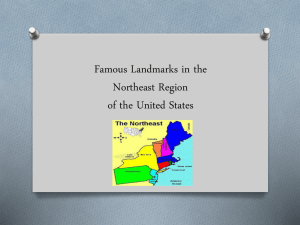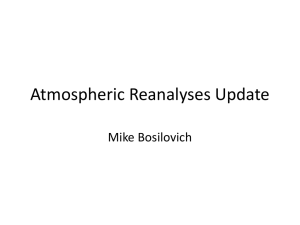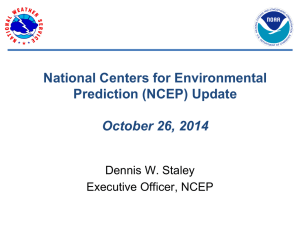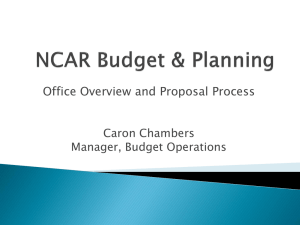Final Presentation (Powepoint 2003)
advertisement
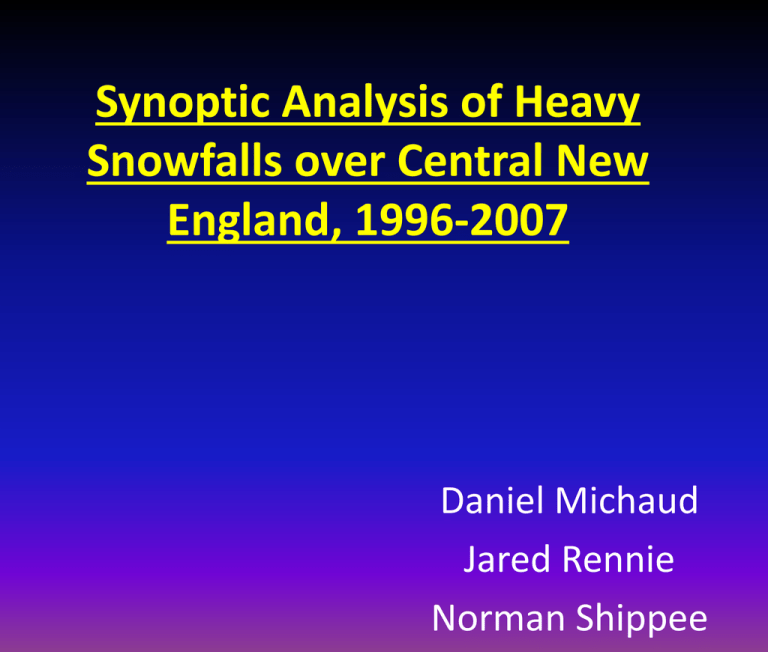
Synoptic Analysis of Heavy Snowfalls over Central New England, 1996-2007 Daniel Michaud Jared Rennie Norman Shippee Introduction and Objectives • Forecasting Snowfall can be a tricky task – Synoptic changes and topographic features can enhance precipitation, as well as inhibit it. • This research concerns itself with the synoptic differences between: – Cases where Plymouth, NH receives significant snowfall – Cases where little or no snowfall was recorded in Plymouth, yet surrounding cities received significant accumulations Data and Methodology • F6 Climatological Data – Winter seasons of 1996 through 2007 – Looked at three cities: • Plymouth, NH • Concord, NH • St. Johnsbury, VT – Defined an “event” as when any one of the above three cities received significant snowfall during a single storm • Determining “Significant Snowfall” – Local NWS definition of a winter storm warning • Area receiving at least seven inches from a single storm (NOAA 2005) Data and Methodology (con’t) • Surface Maps – Determined to classify storm evolution • Lee side cyclogenesis off the Rocky Mountains • Coastal Redevelopment (most cases were this) – Multiple cases were eliminated • Data was split into two groups – Criteria (Plymouth receiving 7”) • 25 cases – Non-Criteria (Plymouth not receiving 7”) • 19 cases Data and Methodology (con’t) • Using local Metars and archived surface maps – Time of snowfall initialization was calculated and inserted into NCEP/NCAR composites • 12 hourly composites were created for the following three cases – All 44 cases (used as a control) – 25 Criteria Cases – 19 Non-Criteria Cases • Generated maps of 250-hPa winds, 500-hPa heights, 700-hPa omega, 850-hPa vector winds/temperatures, sea level pressure and surface winds Results All Data Fig. 1. NCEP/NCAR Composite analysis 24 hours prior to event onset (T-24) for a) 250-hPa vector wind, b) 500-hPa geopotential height, c) 850-hPa temperature, and d) sea-level pressure. a. b. c. d. 0°C Fig. 1. NCEP/NCAR Composite analysis 24 hours prior to event onset (T-24) for a) 250-hPa vector wind, b) 500-hPa geopotential height, c) 850-hPa temperature, and d) sea-level pressure. a. b. c. d. 0°C Fig. 2. NCEP/NCAR Composite analysis 12 hours prior to event onset (T-12) for a) 250-hPa vector wind, b) 500-hPa geopotential height, c) 850-hPa temperature, and d) sea-level pressure. a. b. c. d. 0°C Fig. 3. NCEP/NCAR Composite analysis at event onset (T-0) for a) 250-hPa vector wind, b) 500-hPa geopotential height, c) 850-hPa temperature, and d) sea-level pressure. a. b. c. d. 0°C Fig. 4. NCEP/NCAR Composite analysis 12 hours after event onset (T+12) for a) 250-hPa vector wind, b) 500-hPa geopotential height, c) 850-hPa temperature, and d) sea-level pressure. a. b. c. d. 0°C Fig. 5. NCEP/NCAR Composite analysis 24 hours after event onset (T+24) for a) 250-hPa vector wind, b) 500-hPa geopotential height, c) 850-hPa temperature, and d) sea-level pressure. Criteria cases vs. Non-criteria cases a. b. c. d. Fig. 6. NCEP/NCAR Composite analysis of criteria events for Plymouth, NH 24 hours prior to event onset (T-24) for a) 250-hPa vector wind, b) 500-hPa geopotential height, c) 850-hPa temperature, and d) sea-level pressure. a. b. c. d. Fig. 7. NCEP/NCAR Composite analysis of non-criteria events for Plymouth, NH 24 hours prior to event onset (T-24) for a) 250-hPa vector wind, b) 500-hPa geopotential height, c) 850-hPa temperature, and d) sea-level pressure. a. b. c. d. Fig. 8. NCEP/NCAR Composite analysis of criteria events for Plymouth, NH 12 hours prior to event onset (T-12) for a) 250-hPa vector wind, b) 500-hPa geopotential height, c) 850-hPa temperature, and d) sea-level pressure. a. b. c. d. Fig. 9. NCEP/NCAR Composite analysis of non-criteria events for Plymouth, NH 12 hours prior to event onset (T-12) for a) 250-hPa vector wind, b) 500-hPa geopotential height, c) 850-hPa temperature, and d) sea-level pressure. a. b. c. d. Fig. 10. NCEP/NCAR Composite analysis of criteria events for Plymouth, NH at event onset (T-0) for a) 250-hPa vector wind, b) 500-hPa geopotential height, c) 850-hPa temperature, and d) sea-level pressure. a. b. c. d. Fig. 11. NCEP/NCAR Composite analysis of non-criteria events for Plymouth, NH at event onset (T-0) for a) 250-hPa vector wind, b) 500-hPa geopotential height, c) 850-hPa temperature, and d) sea-level pressure. NonCriteria Criteria Fig. 12. Topographical Map of New Hampshire. Arrows depict surface wind direction. (Image courtesy Color Landform Atlas of the United States) a. b. c. d. Fig. 13. NCEP/NCAR Composite analysis of criteria events for Plymouth, NH 12 hours after event onset (T+12) for a) 250-hPa vector wind, b) 500-hPa geopotential height, c) 850-hPa temperature, and d) sea-level pressure. a. b. c. d. Fig. 14. NCEP/NCAR Composite analysis of non-criteria events for Plymouth, NH 12 hours after event onset (T+12) for a) 250-hPa vector wind, b) 500-hPa geopotential height, c) 850-hPa temperature, and d) sea-level pressure. a. b. c. d. Fig. 15. NCEP/NCAR Composite analysis of events for Plymouth, NH 12 hours after event onset (T+12) for a) criteria surface temperature, b) non-criteria surface temperature, c) criteria surface vector wind, and d) non-criteria surface vector wind. a. b. c. d. Fig. 16. NCEP/NCAR Composite analysis of criteria events for Plymouth, NH 24 hours after event onset (T+24) for a) 250-hPa vector wind, b) 500-hPa geopotential height, c) 850-hPa temperature, and d) sea-level pressure. a. b. c. d. Fig. 17. NCEP/NCAR Composite analysis of non-criteria events for Plymouth, NH 24 hours after event onset (T+24) for a) 250-hPa vector wind, b) 500-hPa geopotential height, c) 850-hPa temperature, and d) sea-level pressure. a. b. c. d. Fig. 18. NCEP/NCAR Composite analysis of events for Plymouth, NH 24 hours after event onset (T+24) for a) criteria surface temperature, b) non-criteria surface temperature, c) criteria surface vector wind, and d) non-criteria surface vector wind. Fig. 19. Topographical Map of New Hampshire. (Image courtesy Color Landform Atlas of the United States) Conclusions • There are several crucial differences in storm evolution within the 24 hours surrounding event onset – Cases meeting criteria in Plymouth are generally colder at low levels – The cyclone in these cases develops slower, deepens rapidly around T+12, takes a track further offshore – Non-criteria cases develop faster due to better mid- and upperlevel dynamics, create more WAA downstream over New England • Low level flow and topographical influences can make or break a large snowfall event in Plymouth – Cases meeting criteria in Plymouth tend to have a period of easterly surface winds at event onset whereas non-criteria cases tend to have northeasterly flow (terrain blocking) – Non-criteria cases tend to have stronger cold advection soon after (T+24) event onset on a west-northwesterly flow (a dry, downsloping direction) – Criteria cases have north to northeasterly flow at this time period, allowing for continued access to Atlantic moisture and the possibility of wrap-around precipitation to continue across the area Works Cited • HPC, cited 2007: Surface Analysis Archive. [available online at http://www.hpc.ncep.noaa.gov/html/sfc_archive.shtml] • Kocin, Paul J and Uccellini, Louis W, 2004: Northeast Snowstorm: Volume I: Overview, Volume II: The Cases. Meteorological Monograph Series, 818 pp. • NCDC, cited 2007: Unedited Local Climatological Data. [available online at http://cdo.ncdc.noaa.gov/ulcd/ULCD] • NCEP/NCAR, cited 2006: 6-Hourly Reanalysis Data Composites. [available online at http://www.cdc.noaa.gov/Composites/Hour/] • NWS Gray, Maine Climate Data, cited 2007: Monthly F6 Climate Statistics. [available online at http://www.erh.noaa.gov/er/gyx/climate_f6.shtml] • PSU Vortex, cited 2007: Product Generator for Archive Data. [available online at http://vortex.plymouth.edu] • Unisys Weather, cited 2007: Image and Map Archive. [available online at http://weather.unisys.com/archive/index.html] QUESTIONS??? GO BILLS!!! …next year



